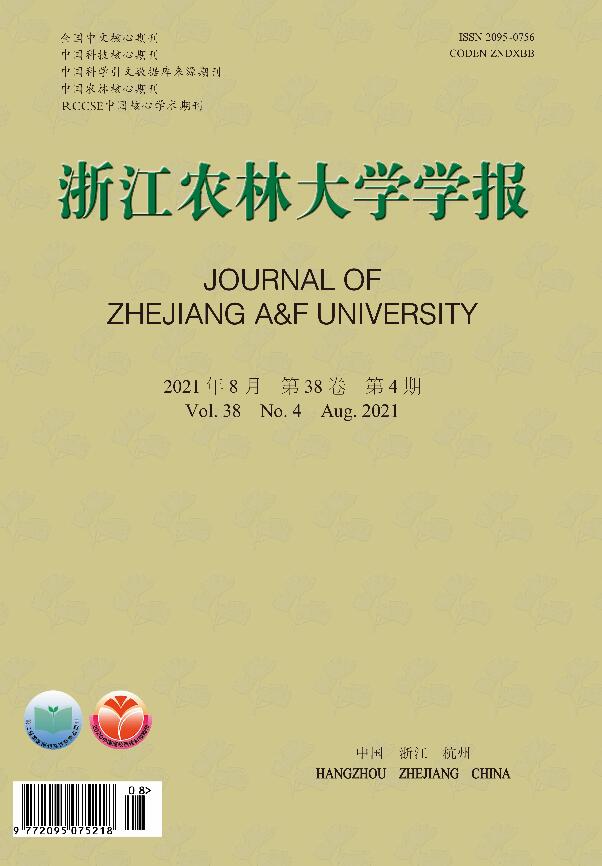-
二氧化碳(CO2)、甲烷(CH4)、氧化亚氮(N2O)是引起全球温室效应最主要的3种温室气体[1],其排放持续增加将会导致全球气候变暖加剧。森林土壤汇集了全球土壤73%的碳库[2],是温室气体重要的吸收汇、排放源和转换器[3],对调节全球气候变化及碳、氮平衡具有至关重要的作用。研究表明[4-5]:森林演替、土地利用方式改变及森林过度采伐均会导致森林土壤温室气体排放通量上升,尤其是后两者引起的CO2排放通量约占人类碳排放总量的30%,是全球CO2排放通量大幅度增加的最主要原因之一。因此,合理利用现有林地,科学经营森林,探究各因素对土壤温室气体排放的影响机制,对减缓全球温室效应意义重大,也是当前国内外的研究热点。杉木Cunninghamia lanceolata是中国优质速生丰产的乡土针叶树种,人工栽培面积大[6],在缓解木材需求压力、增加农民经济效益方面作用突出,同时杉木具有巨大的固碳潜力,对缓解气候变化起到不可忽视的作用[7-10]。但杉木纯林存在土壤肥力衰退、土壤质量下降等问题[11],极易遭受周边毛竹Phyllostachys edulis的入侵。毛竹是中国特有高大散生无性系克隆植物[12],因其特殊生物学特性和优越的固碳能力成为中国优势碳汇造林树种[13]。毛竹林生物碳储量较高[14-15],年平均碳吸收量为8.13 Mg·hm−2[16],远高于马尾松Pinus massoniana及其他常绿阔叶林树种。但由于毛竹繁殖能力强大,毛竹产量快速增长。近年来国内市场毛竹价格下滑,竹农的经营积极性大大降低,许多地区出现大面积抛荒毛竹林[17]。抛荒后毛竹入侵周边林分的速度加快,入侵现象愈加明显,蚕食周边林分愈加严重,区域生物多样性受到严重威胁。遭受毛竹入侵的杉木林土壤肥力、pH、含水率等理化性质和微生物群落结构均会发生相应变化,进而影响土壤温室气体排放[18]。为探究杉木林土壤温室气体排放对毛竹入侵及采伐的短期响应,本研究以毛竹纯林(毛竹林)、采伐入侵毛竹后的杉木释放林(释放林)、毛竹-杉木混交林(混交林)和杉木纯林(杉木林)作为研究对象,比较毛竹入侵、采伐前后土壤温室气体排放差异及主要影响因素,为毛竹入侵、采伐对杉木林土壤温室气体排放的短期影响提供基础数据,也为科学管控毛竹入侵问题提供理论依据。
HTML
-
研究区浙江省杭州市临安区於潜镇南山村(30°19′N,119°39′E)位于杭州市西部,为典型亚热带季风气候。研究区四季分明,雨量充沛,光照充足,年平均降水日158 d,年平均降水量1 613.9 mm,主要集中于6−8月,其中降水量最多为6月(328.5 mm),最少为12月(44.3 mm)。年平均气温16.4 ℃,最高气温出现在8月(28.4 ℃),最低1月(5.1 ℃)。年平均无霜期237 d,年平均日照时数1 847.3 h,样地全境地貌以中低山丘陵为主,主要土壤类型为酸性红壤,森林覆盖率81.93%。
-
于研究区毛竹入侵杉木地段选择坡向(均为东北朝向)、坡度、地形、海拔等初始条件基本一致的毛竹林、释放林、混交林、杉木林等4种林分,分别在各林分上、中、下3个区域各随机设置1个温室气体排放通量观测点,共计12个点,安装静态箱。静态箱底座在测量温室气体前1个月安装完成,安装时插入土壤5 cm处,避开树木的根及毛竹的竹鞭,并保证其密封性。样地布置工作于2019年6月完成。各林分基本情况如表1所示。
林分
类型pH 海拔/m 郁闭度 毛竹密度/
(株·hm−2)杉木密度/
(株·hm−2)毛竹林 4.08±0.14 b 170 0.80 2 067±117 b 释放林 4.46±0.08 a 170 0.75 889±189 b 混交林 4.43±0.10 a 180 0.85 1 092±259 a 878±214 b 杉木林 4.14±0.11 b 190 0.90 1 733±157 a 说明:数据为平均值±标准误。同列不同小写字母表示不 同林分差异显著(P<0.05) Table 1. General situation of four types of stands
-
于2019年7−12月进行土壤温室气体排放通量监测。每月中旬选典型晴天采集气体,采样时间9:00−11:00。每隔10 min用100 mL注射器采集90 mL气体,共采集4次,密封带回实验室,用气相色谱仪(GC-2014, Shimadzu Inc, Kyotob, 日本)检测CO2、N2O和CH4,计算土壤温室气体通量:F=ρ×(dc/dt)×H×273/(273+t)。其中:F为被测温室气体排放通量(mg·m−2·h−1);ρ为标准状态下被测气体密度(kg·m−3);dc/dt为被测气体浓度随时间变化率;H为静态箱高度(m);t为采气时温度(℃)。
采气的同时,测定各静态箱附近10 cm土层处的温度,采集0~20 cm表层土壤,测定土壤含水率、pH、铵态氮(
$ {\rm{NH}}^{+}_{4}\text{-}{\rm{N}} $ )、硝态氮($ {\rm{NO}}^{-}_{3}\text{-}{\rm{N}} $ )、微生物生物量碳(MBC)、微生物生物量氮(MBN)。其中土壤含水率用烘干法测定;土壤pH用数显玻璃电极测定(水土质量比为5∶1);$ {\rm{NH}}^{+}_{4}\text{-}{\rm{N}} $ 、$ {\rm{NO}}^{-}_{3}\text{-}{\rm{N}} $ 用氯化钾浸提-比色法测定[19];土壤MBC、MBN用氯仿熏蒸法测定[20]。所有数据均为3次重复处理平均值±标准误。 -
用SPSS 16.0和Excel 2013分析数据。采用单因素方差分析和最小显著性差异法检验不同林分土壤温室气体排放通量差异显著性;采用Pearson相关分析法分析温室气体通量与各项土壤指标间相关性。
1.1. 研究区概况
1.2. 样地设置
1.3. 研究方法
1.4. 数据分析
-
由表2可知:不同林分土壤CO2排放通量均随月份变化逐渐减小;7月土壤CO2排放通量均最大,其中毛竹林排放通量为1 362.83 mg·m−2·h−1,分别是释放林、混交林、杉木林的1.28、1.43和1.89倍;9月开始土壤CO2排放通量显著减小(P<0.05),至12月达到最小值;12月土壤CO2排放通量从大到小依次为毛竹林、释放林、混交林、杉木林。4种林分土壤CO2月平均通量差异显著(P<0.05),与杉木林相比,混交林、释放林土壤CO2排放通量分别增加24.59%、61.46%。
林分 CO2排放通量/(mg·m−2·h−1) 7月 8月 9月 10月 11月 12月 月平均通量 毛竹林 1362.83±45.50 Aa 1355.47±64.51 Aa 976.98±10.75 Ba 678.60±14.14 Ca 389.90±64.57 Da 201.54±17.49 Ea 827.55±14.41 a 释放林 1067.60±67.46 Ab 906.95±63.96 Bb 525.57±38.42 Cb 280.36±26.53 Db 78.67±6.26 Eb 51.39±5.17 Eb 485.09±28.33 b 混交林 951.70±45.80 Ab 533.83±16.15 Bc 479.24±53.94 Bb 175.66±22.53 Cc 57.07±13.21 Db 48.46±5.34 Db 374.33±7.90 c 杉木林 719.63±22.33 Ac 481.77±18.67 Bc 408.80±14.19 Cb 115.99±7.88 Dc 44.08±5.67 Eb 32.35±3.31 Eb 300.44±2.95 d 林分 N2O排放通量/(µg·m−2·h−1) 7月 8月 9月 10月 11月 12月 月平均通量 毛竹林 190.36±19.48 Aa 163.02±8.36 ABa 145.95±15.68 ABa 122.82±12.08 Ba 55.59±3.53 Ca 47.40±7.09 Ca 120.86±4.06 a 释放林 158.04±7.80 Aab 139.15±8.44 Aa 125.78±14.99 Aab 67.64±6.06 Bb 61.16±5.24 Ba 36.44±4.86 Ba 98.03±5.63 b 混交林 138.19±5.80 Ab 132.87±16.12 Aa 106.52±10.42 Aab 49.41±9.44 Bb 36.90±9.26 Ba 33.47±5.48 Ba 82.89±3.16 c 杉木林 129.26±12.96 Ab 118.20±20.84 Aa 77.07±12.08 Bb 37.21±5.54 BCb 35.35±8.97 BCa 24.28±3.42 Ca 70.23±2.54 c 林分 CH4吸收通量/(µg·m−2·h−1) 7月 8月 9月 10月 11月 12月 月平均通量 毛竹林 192.28±17.14 Aa 196.35±5.15 Aa 163.82±9.69 ABa 155.25±10.89 ABa 123.95±8.55 BCa 100.62±11.31 Ca 155.38±7.29 a 释放林 165.62±14.46 Aa 167.35±14.12 Aa 141.02±11.79 ABa 132.34±12.60 ABab 123.18±8.70 ABa 92.04±9.20 BAa 135.26±0.85 b 混交林 179.35±8.90 Aa 179.86±14.11 Aa 147.69±16.98 ABa 136.48±5.54 ABab 128.53±7.34 Ba 102.68±9.65 Ba 145.77±2.34 ab 杉木林 159.07±9.29 Aa 151.44±10.73 Aa 136.18±16.50 ABa 110.88±8.71 BCc 95.10±3.95 CDa 65.05±4.75 Da 119.62±2.82 c 说明:同行不同大写字母表示不同月份间差异显著(P<0.05);同列不同小写字母表示不同林分间差异显著(P<0.05) Table 2. Soil greenhouse gases fluxes of four types of forests
土壤N2O排放通量最高值出现在7月,此时,从大到小分别为毛竹林(190.36 µg·m−2·h−1)、释放林(158.04 µg·m−2·h−1)、混交林(138.19 µg·m−2·h−1)和杉木林(129.26 µg·m−2·h−1),最低值均出现在12月。从平均通量来看,毛竹林比其他3种林分分别高出23.29%、45.81%和72.09%,且差异显著(P<0.05),混交林与杉木林间差异不显著(P>0.05)。
4种林分均表现为CH4吸收汇。其中杉木林土壤CH4吸收通量最大值出现在7月,其他3种林分均出现在8月;4种林分最小值均出现在12月。7−10月,土壤CH4吸收通量从大到小均为毛竹林、混交林、释放林、杉木林。11月开始混交林(128.53 µg·m−2·h−1)超过毛竹林(123.95 µg·m−2·h−1)成为最大的土壤CH4吸收汇。4种林分土壤月平均CH4吸收通量从大到小依次为毛竹林、混交林、释放林、杉木林。
-
由表3可知:土壤温度具有明显的季节动态变化规律,7−10月,4种林分土壤温度逐渐降低,11月后趋于稳定。混交林月平均温度显著高于其他3种林分(P<0.05),从大到小依次为:混交林(19.77 ℃)、释放林(18.72 ℃)、毛竹林(18.49 ℃)、杉木林(18.32 ℃)。4种林分土壤含水率波动较大,最大值均出现在7月,最小值均出现在11月。释放林土壤月平均含水率最高(27.32%),分别是杉木林、毛竹林、混交林的1.19、1.46、1.67倍。由表4可知:释放林土壤
$ {\rm{NH}}^{+}_{4}\text{-}{\rm{N}} $ 质量分数显著高于其他3种林分(P<0.05),其他3种林分之间差异不显著(P>0.05),说明采伐毛竹对$ {\rm{NH}}^{+}_{4}\text{-}{\rm{N}} $ 质量分数具有显著影响。土壤pH、$ {\rm{NO}}^{-}_{3}\text{-}{\rm{N}} $ 、MBC、MBN等其他指标林分间差异不显著(P>0.05)。林分 土壤温度/℃ 7月 8月 9月 10月 11月 12月 月平均温度 毛竹林 23.31±0.25 a 25.72±0.07 b 25.03±0.06 a 15.00±0.00 b 8.82±0.17 a 9.05±0.08 a 18.49±0.07 b 释放林 28.91±1.12 a 25.27±0.23 b 23.80±0.00 b 15.28±0.19 b 9.17±0.35 a 9.90±0.18 a 18.72±0.22 b 混交林 29.06±0.55 a 26.95±0.40 a 24.89±0.19 a 17.62±0.34 a 10.33±0.48 a 9.77±0.26 a 19.77±0.24 a 杉木林 26.73±0.55 a 24.80±0.13 b 23.48±0.06 b 15.57±0.27 b 9.62±0.34 a 9.72±0.29 a 18.32±0.09 b 林分 土壤含水率/% 7月 8月 9月 10月 11月 12月 月平均含水率 毛竹林 31.19±4.06 b 20.24±4.39 b 22.27±1.51 bc 15.33±2.18 b 10.47±0.42 a 12.51±0.41 a 18.67±1.96 bc 释放林 47.75±0.85 a 32.35±1.91 a 32.23±0.92 a 21.67±0.63 a 13.31±2.08 a 16.59±0.89 a 27.32±0.32 a 混交林 29.20±3.97 b 19.63±2.34 b 16.67±3.01 c 11.98±0.67 b 7.12±0.55 a 13.56±1.00 a 16.36±1.75 c 杉木林 38.58±0.89 ab 25.41±1.17 ab 28.15±1.98 ab 16.85±1.23 b 13.03±1.86 a 16.22±2.62 a 23.04±1.54 ab 说明:同列不同小写字母表示不同林分间差异显著(P<0.05) Table 3. Soil temperature and soil moisture content of four types of forests
林分 pH $ { {\rm{NH}_4^{+} }\text{-}{\rm{N} } }$ /(mg·kg−1) $ { {\rm{NO}_3^{-} }\text{-}{\rm{N} } }$ /(mg·kg−1) MBC/(mg·kg−1) MBN/(mg·kg−1) 毛竹林 4.03±0.06 a 6.27±0.75 b 11.37±1.95 a 615.57±81.88 a 116.17±22.55 a 释放林 4.21±0.08 a 12.53±1.74 a 16.90±2.06 a 767.26±45.22 a 129.51±12.63 a 混交林 4.26±0.01 a 5.67±1.52 b 16.39±3.79 a 708.71±91.09 a 143.19±17.07 a 杉木林 4.20±0.02 a 6.03±0.93 b 17.70±1.35 a 511.87±60.59 a 103.56±13.43 a 说明:同列不同小写字母表示不同林分间差异显著(P<0.05) Table 4. Soil physical and chemical properties of four types of forests
-
相关性分析显示(表5):4种林分土壤CO2、N2O排放通量及CH4吸收通量均与土壤温度、土壤含水率呈极显著正相关(P<0.01),与
$ {\rm{NH}}^{+}_{4}\text{-}{\rm{N}} $ 、$ {\rm{NO}}^{-}_{3}\text{-}{\rm{N}} $ 呈正相关(P>0.05);与MBC呈负相关(P>0.05)。杉木林土壤CO2、N2O排放通量及CH4吸收通量与土壤pH呈极显著正相关(P<0.01)。林分 气体 土壤温度 土壤含水率 土壤pH ${ {\rm{NH}}^{+}_{4}\text{-}{\rm{N}} }$ ${ {\rm{NO}}^{-}_{3}\text{-}{\rm{N}}} $ MBC MBN 毛竹林 CO2 0.944** 0.760** −0.731 0.933** 0.851* −0.710 −0.029 N2O 0.914** 0.744** −0.941** 0.759 0.615 0.726 −0.266 CH4 0.838** 0.568* −0.591 0.480 0.688 −0.544 0.122 释放林 CO2 0.957** 0.924** 0.705 0.912* 0.838* −0.559 0.187 N2O 0.938** 0.882** 0.735 0.986** 0.855* −0.594 0.047 CH4 0.796** 0.677** 0.800 0.727 0.709 −0.058 0.395 混交林 CO2 0.913** 0.863** 0.979** 0.660 0.108 −0.317 0.857* N2O 0.915** 0.789** 0.991** 0.732 0.348 −0.226 0.878* CH4 0.802** 0.586* 0.833* 0.759 0.314 −0.006 0.926** 杉木林 CO2 0.952** 0.926** 0.956** 0.871* 0.698 −0.713 0.460 N2O 0.868** 0.773** 0.945** 0.844* 0.673 −0.787 0.304 CH4 0.882** 0.744** 0.949** 0.611 0.537 −0.722 0.343 说明:*表示P<0.05,**表示P<0.01 Table 5. Pearson correlation coefficient among soil greenhouse gases fluxes and soil properties
2.1. 不同林分土壤温室气体排放通量特征
2.2. 不同林分环境因子及土壤理化性质变化
2.3. 土壤温室气体排放与土壤理化性质的相关性分析
-
植被覆盖变化显著影响土壤碳库与土壤呼吸过程。毛竹入侵及采伐引起植被变化,其群落物种组成、凋落物特征、土壤理化性质和生物学性质也发生了根本性的转变,从而显著影响土壤的碳库动态特征。本研究表明:毛竹林、释放林、混交林和杉木林均表现为土壤CO2、N2O的排放源及土壤CH4的吸收汇。XU等[21]发现毛竹入侵会改变群落结构,增加细菌多样性,使得土壤异养呼吸加强,土壤CO2排放通量增加,这与本研究结果一致。释放林土壤CO2排放通量显著高于杉木林(P<0.05),可能原因是:采伐毛竹后林分郁闭度减小,林下光照增加,土壤温度上升,土壤有机质分解加速,土壤呼吸增强。毛竹林与混交林土壤CO2排放通量显著高于杉木林(P<0.05),一方面是毛竹林、混交林土壤温度略高,而土壤CO2排放与土壤温度呈指数型极显著正相关[22];另一方面,毛竹种群在扩张过程中,细根生物量空间分布格局发生明显变化,细根生物量及比例显著增加[23],从而导致土壤CO2排放通量增加。
土壤排放的N2O主要是土壤微生物硝化和反硝化作用产生的。本研究发现:混交林土壤N2O排放通量高于杉木林。徐道炜[24]研究指出:毛竹入侵杉木林,林地表层土壤水溶性有机碳增加,作为微生物重要的可利用能源物质,土壤水溶性有机碳含量升高增强了土壤硝化、反硝化作用,使得土壤N2O排放通量增加。释放林土壤N2O排放通量显著高于杉木林(P<0.05)。毛竹采伐后,释放林的土壤含水率增加,采伐剩余物归还量较大,这两者同时促进土壤反硝化进程,提高了土壤N2O排放通量。这与DARMENMANN等[25]和YASHIRO等[26]的研究结果相似。
BORKEN等[27]研究发现:较高的土壤含水率会抑制CH4在氧气(O2)中的扩散能力,减少林分对土壤CH4的吸收。本研究表明:释放林土壤CH4吸收能力显著低于毛竹林和混交林(P<0.05),这与ZERVA等[28]研究结果一致。释放林土壤含水率高于其他林分,土壤CH4排放增加,可能是释放林土壤CH4吸收通量低于毛竹林和混交林的原因。土壤无机氮(
$ {\rm{NH}}^{+}_{4}\text{-}{\rm{N}} $ 、${\rm{NO}}^{-}_{3}\text{-}{\rm{N}} $ )含量也会影响土壤CH4排放。研究[29]表明:土壤$ {\rm{NH}}^{+}_{4}\text{-}{\rm{N}} $ 质量分数增加使得土壤中的氨氧化细菌活性增强,而氨氧化细菌在一定条件下具有氧化CH4能力,一定程度上抵消了$ {\rm{NH}}^{+}_{4}\text{-}{\rm{N}} $ 对甲烷氧化菌的竞争性抑制作用。释放林土壤$ {\rm{NH}}^{+}_{4}\text{-}{\rm{N}} $ 质量分数高于混交林也可能是造成土壤CH4吸收通量降低的主要原因。土壤CH4吸收能力还受土壤pH影响。好氧条件下,土壤甲烷氧化菌最佳pH为5.0~6.0,耐酸性要高于甲烷产生菌[30];毛竹入侵降低了土壤pH,有利于甲烷氧化菌氧化CH4,从而增加土壤CH4吸收能力。因此,毛竹入侵及采伐对土壤CH4吸收通量造成的影响是多个影响因子共同作用的结果。综上所述,毛竹入侵及采伐后,杉木林表层土壤温室气体排放通量增加,对区域大气环境造成一定程度负面影响,建议由采伐毛竹改为挖笋等措施来控制毛竹入侵。 -
土壤温度和含水率对土壤温室气体排放具有显著影响[29]。4种林分土壤温室气体排放与吸收呈明显动态变化特征,即夏高冬低,这与已有的研究结果一致[31-32]。相关性分析表明:土壤CO2、N2O排放、CH4吸收均与土壤温度呈极显著正相关(P<0.01),这与严俊霞等[33]对山西高原落叶松Larix gmelini人工林土壤呼吸研究、王磊等[34]对亚热带湿地松Pinus elliottii林研究及FENDER等[35]对温带落叶林土壤温室气体排放强度研究结果一致。可能的原因是:①在一定温度范围内,土壤温度上升会加强土壤微生物活性和土壤有机质分解作用,加大土壤温室气体排放量[36];②在亚热带森林,在土壤水分及底物充足前提下,土壤温度上升会增强土壤氮素矿化作用,使得土壤N2O排放量增加[37];③好氧条件下,土壤温度升高,甲烷氧化菌繁殖速度加快、活性加强,对土壤CH4的消耗增加[38],即CH4吸收量增加。
3种温室气体排放与土壤含水率均呈极显著正相关(P<0.01),这与朱旭丹[39]的研究结果相似;土壤含水率对土壤温室气体排放造成显著影响,与高升华等[40]发现亚热带黑杨Populus nigra人工林土壤CH4吸收通量与土壤水分并不存在相关性结果不同。原因可能是土壤CH4吸收通量不仅受土壤含水率影响,而是受多个影响因子共同作用。就土壤CO2、N2O排放而言,土壤含水率的影响体现在3个方面:①土壤含水率增加,植物根系生长量随之提高,导致植物根系呼吸作用大大增强[41];②含水率增加提升了土壤可溶性有机质有效性及可移动性,作为土壤微生物呼吸底物及活动能量来源[42],可溶性有机质对增强微生物呼吸作用、硝化/反硝化作用产生不可忽视影响;③土壤含水率上升,土壤微生物数量及种类也随之增加,导致土壤温室气体排放作用加强[43]。
-
谢军飞等[44]研究表明:土壤CO2排放主要来源于植物自养呼吸及动物、微生物的异养呼吸,
$ {\rm{NH}}^{+}_{4}\text{-}{\rm{N}} $ 、$ {\rm{NO}}^{-}_{3}\text{-}{\rm{N}} $ 作为土壤有效氮主要组成部分,其质量分数增加有利于有机质分解,促进细根生长、生物生产量和微生物活性,从而增强土壤CO2各个环节排放通量,与本研究结果一致。相关性分析表明:土壤CO2排放与$ {\rm{NH}}^{+}_{4}\text{-}{\rm{N}} $ 、$ {\rm{NO}}^{-}_{3}\text{-}{\rm{N}} $ 呈显著正相关(P<0.05),4种林分土壤N2O排放通量与土壤$ {\rm{NH}}^{+}_{4}\text{-}{\rm{N}} $ 、$ {\rm{NO}}^{-}_{3}\text{-}{\rm{N}} $ 质量分数亦呈正相关。这可能是因为$ {\rm{NH}}^{+}_{4}\text{-}{\rm{N}} $ 、$ {\rm{NO}}^{-}_{3}\text{-}{\rm{N}} $ 分别作为硝化、反硝化过程底物,其质量分数增加,促进土壤N2O生产过程,从而增加土壤N2O排放。土壤甲烷氧化菌氧化大气CH4是土壤吸收CH4的主要途径,而土壤无机氮通过影响CH4氧化改变土壤CH4吸收通量。BODELIER等[45]利用分子探针及PCR技术发现
$ {\rm{NH}}^{+}_{4}\text{-}{\rm{N}} $ 能够促进甲烷氧化菌增加。本研究中,4种林分土壤CH4吸收通量与$ {\rm{NH}}^{+}_{4}\text{-}{\rm{N}} $ 均呈正相关,说明亚热带地区$ {\rm{NH}}^{+}_{4}\text{-}{\rm{N}} $ 含量越高CH4吸收能力越强。土壤$ {\rm{NH}}^{+}_{4}\text{-}{\rm{N}} $ 作为甲烷氧化菌主要氮源,其含量增加直接促进甲烷氧化菌生命活动,有利于CH4氧化,从而增加CH4吸收通量[46]。但也有研究发现$ {\rm{NH}}^{+}_{4}\text{-}{\rm{N}} $ 会抑制甲烷营养菌活性并减少CH4吸收通量[47]。由此推断,本研究中$ {\rm{NH}}^{+}_{4}\text{-}{\rm{N}} $ 对土壤CH4吸收的影响可能是前者作用效果大于后者造成。微生物生物量碳是土壤重要的活性有效碳源,可为土壤微生物活动提供丰富的能量底物,影响参与土壤温室气体排放的各个生物化学过程。本研究表明:不同林分土壤CO2、N2O排放、CH4吸收均与土壤MBC质量分数呈负相关,这与MUHAMMAD[48]在变性土中的研究结果相似。方慧云[22]研究表明:土壤CO2、CH4排放与土壤MBC质量分数呈正相关,这与本研究结果不一致。这可能是因为:①影响土壤温室气排放机制的因素复杂,土壤MBC虽对土壤微生物活性起到促进作用,但并不是影响土壤温室气体排放的主要影响因子[49];②土壤MBC对土壤温室气体排放的影响因林分类型、经营措施、环境状况等不同而呈现不同相关性[50]。







































 DownLoad:
DownLoad: